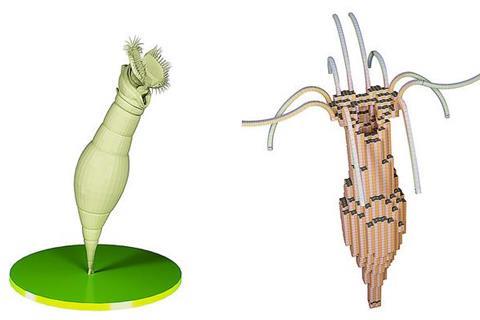A recent perspective review published in the very high impact journal Advanced Materials this month by researchers at the Research Center for Materials, Architectures and Integration of Nanomembranes (MAIN) of Chemnitz University of Technology, shows how a novel form of high-information-content Living Technology is now within reach, based on microrobotic electronic modules called SMARTLETs, which will soon be capable of self-assembling into complex artificial organisms.

The research belongs to the new field of Microelectronic Morphogenesis, the creation of form under microelectronic control, and builds on work over the previous years at Chemnitz University of Technology to construct self-folding and self-locomoting thin film electronic modules, now carrying tiny silicon chiplets between the folds, for a massive increase in information processing capabilities.
Sufficient information can now be stored in each module to encode not only complex functions but fabrication recipes (electronic genomes) for clean rooms to allow the modules to be copied and evolved like cells, but safely because of the gating of reproduction through human operated clean room facilities.
Electrical self-awareness
In addition, the chiplets can provide neuromorphic learning capabilities allowing them to improve performance during operation.
A further key feature of the specific self-assembly of these modules, based on matching physical bar codes, is that electrical and fluidic connections can be achieved between modules. These can then be employed, to make the electronic chiplets on board “aware” of the state of assembly, and of potential errors, allowing them to direct repair, correct mis-assembly, induce disassembly and form collective functions spanning many modules.
Such functions include extended communication (antennae), power harvesting and redistribution, remote sensing, material redistribution etc.
Vital for sustainability
The complete digital fab description for modules, for which only a limited number of types are required even for complex organisms, allows their material content, responsible originator and environmentally relevant exposure all to be read out.
Prof. Dagmar Nuissl-Gesmann from the Law Department at Chemnitz University of Technology observes that “this fine-grained documentation of responsibility intrinsic down to microscopic scales will be a game changer in allowing legal assignment of environmental and social responsibility for our technical artefacts”.
Furthermore, the self-locomotion and self-assembly-disassembly capabilities allows the modules to self-sort for recycling. Modules can be regained, reused, reconfigured, and redeployed in different artificial organisms. If they are damaged, then their limited and documented types facilitate efficient custom recycling of materials with established and optimized protocols for these sorted and now identical entities.
Setting the bar
Prof. Marlen Arnold, an expert in Sustainability of the Faculty of Economics and Business Administration, observes: “Even at high volumes of deployment use, these properties could provide this technology with a hitherto unprecedented level of sustainability which would set the bar for future technologies to share our planet safely with us.”
This research is a first contribution of MAIN/Chemnitz University of Technology, as a new member of the European Centre for Living Technology ECLT, based in Venice,” says Prof. Oliver G. Schmidt, Scientific Director of the Research Center MAIN.
“It’s fantastic to see that our deep collaboration with ECLT is paying off so quickly with immediate transdisciplinary benefit for several scientific communities.”
“Theoretical research at the ECLT has been urgently in need of novel technology systems able to implement the core properties of living systems.” comments Prof. John McCaskill, coauthor of the paper, and a grounding director of the ECLT in 2004.







No comments yet